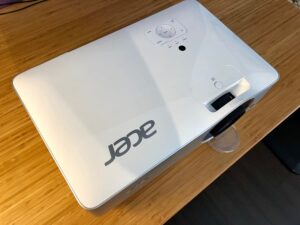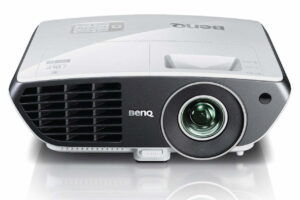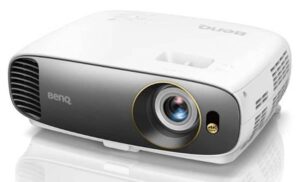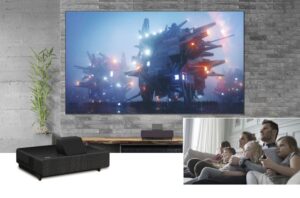As one of the very first DLP projectors to feature 4K pixel density, the Optoma UHD60 is a big, bulky projector that comes with an equally big picture size. You can also check out the Optoma HD143X.
But the same question remains that we’ve been asking with every 4K projector we’ve reviewed this year: is the cost really worth the effect of having a 4K picture the size of your wall if you can only appreciate it during nighttime viewing hours?
Read on in our Optoma UHD60 4K projector review to find out!
Optoma UHD60 4K Projector Hands-On Review
Price: $1,799.00
Model: UHD60
Summary: The Optoma UHD60 is a surprisingly cheap 4K projector that had exceptional picture quality and fidelity when compared to projectors more than twice the cost — save for some middling HDR results overall.
What We Liked
- Stellar picture quality in most scenarios
- Solid price for what you get
- Onboard speakers were surprisingly boomy
What We Didn’t
- HDR quality could be better
- Ambient light washes out any 4K/HDR benefits
Optoma UHD60 Specs
 | |
| Screen Size | 26.45″ – 302.2″ |
| Native Resolution | 3840 x 2160 |
| Aspect Ratio | 16:9 |
| Lumens | 3,000 |
| Contrast Ratio | 1,000,000:1 |
| Refresh Rates | 60Hz |
| 3D Capable? | |
| Display Technology | DLP |
| Short Throw? | |
| HDMI Ports | 1 1.4, 1 2.0/2.2MHL |
| Onboard Speakers | 2 4W |
| Weight | 16.0 lbs |
| Device Dimensions | 19.6 x 13 x 6 inches |
| Price | $1,799 |
| Buy Now |
Optoma UHD60 Design
As is the case with most 4K projectors, there’s nothing “small” about what the Optoma UHD60 brings to the table, which is similar to what the Optoma UHD51A has to offer. This is a big beast of a projector (one of the biggest we’ve ever reviewed in fact), but even though it may take up half your living room it won’t exactly look bad doing it.
When we reviewed the Acer VL7860 we noted there was nothing special about the boxy, flat-white design and although some similar notes could be said about the UHD60, it’s still a surprisingly curvaceous projector that skews some of the more familiar grated design elements we’ve seen on Optoma projectors before it. You can see this in our review of the Optoma UHZ65 projector.
The projector is completely svelte on the top save for a small line that runs across the middle, hiding the secret panel which opens up the case to let you tweak the lens shift ratio as well as the overall zoom and fine-tuning that would normally be placed on the outside of the unit.
The company has also opted to place the lens housing directly in the middle of the unit rather than off to the side (as we’ve seen in literally every Optoma projector to date). This could make certain mounting situations a bit more complicated if that’s the way you’ve configured your ceiling bracket previously, but outside of that limited scenario I actually appreciate the look of having the lens dead-center and staring straight out the way it is in the UHD60.
Read Next: The Top Rated Projector Screens
Optoma UHD60 Hardware
Unlike the Sony 4K projector, the Optoma UHD60 4K projector uses DLP technology to create its images at a maximum display resolution of 3840 x 2160, with a contrast ratio of 1,000,000:1 and ANSI lumen rating of 3000, with the ability to show an image as large as 302.2″ across from corner to corner at a distance of 30.5 feet.
The Optoma UHD60 sports two HDMI ports (one 1.4, one HDMI 2.0/MHL 2.2), one VGA-in, one RJ-45 Ethernet port as well as a USB port, and two jacks for audio in and audio out.
Optoma UHD60 User Interface and Settings
The Optoma UHD60 uses a standard set of menu options that don’t deviate really at all from what we’ve seen on previous Optoma models, save for a few extra settings that are specific to the 4K UHD portion of this display technology. These included the option to turn on the Dynamic Blacks setting (which we always recommend when watching movies, but not so much when playing a game), and of course the ability to switch on HDR which is exclusive to any 4K projectors produced by the company.
Read Next: The Top 4k Projectors
Testing and Performance of the Optoma UHD60 4K Projector
Brightness/Picture Quality

Going into this review I have to admit I wasn’t expecting too much from the DLP-powered Optoma UHD60 in terms of picture quality when compared to more robust options like the laser-powered Acer VL7860, but was pleasantly surprised to find that on almost all tests and sources we could throw at it performed equally well, if not above the curve in some scenarios. Considering that the UHD60 costs less than half of what the VL7860 does, that’s a very impressive feat unto itself.
During our standard Spiderman: Homecoming 4K Blu-Ray viewing we found the picture quality to be just around what we got out of the VL7860, save for one small issue that seems to nag most 4K projectors that have been released in the past year or so: HDR quality. HDR is still a new technology for standard televisions, so it’s not all too shocking that the projector market is still working to refine how the color spec will fold into their market with aging chip applications like DLP. In this department, the VL7860 definitely pulled out ahead thanks to the addition of its laser technology, but the two were back on even footing when it came to ambient light performance. Even with “Bright” mode turned on and everything tuned as much as possible, 3,000 lumens just doesn’t seem to be enough to overcome the issues that ambient light presents for 4K projectors. If you don’t have a specifically blacked-out room to watch in, you’ll probably want to stick with a standard 4K flatscreen option instead.
Read Next: Top Projector Under $1000
That said you still get way more than what you’re paying for if you’re comparing the two on a purely cost-based basis. 4K images were crisp, clean, and suffered almost no color bleed that we’ve seen on lesser projectors, and the projector was more than capable of handling action scenes without losing any of the fidelity we’ve come to expect from 4K flatscreen sets or higher priced projectors in the same bracket of features and performance.
- Gaming Performance: At a max refresh rate of 60Hz, which is double that on the BenQ TH671ST, we definitely didn’t get everything we would have liked to out of the UHD60 in this department, and the input lag was even less bearable. That said the HDR effect still makes games look better than they ever have before, and the immersive effect of having your favorite titles blown up to over 100″ in 4K simply can’t be understated at this price.
- 3D Performance: 3D performance at 1080p (the highest rate you can use the feature at) looked just fine on the Optoma UHD60, about as good as every other Optoma projector we’ve reviewed in this department. For a nicer 1080p resolution, check out the ViewSonic 1080p projector.
- Noise and Heat: Even though we were hoping that the advancements made to the DLP chip that allowed it to display 4K content would carry over to lesser noise and heat, the UHD60 ran pretty damn hot under the collar with a max temperature output of 115°, and a max decibel rating of 43dB from an ambient rating of 34dB.
- Sound: Although normally this would be the part of the review where we once again malign the limitations of onboard sound systems for projectors, we were pleasantly surprised to find a considerable amount of fidelity and bass being pumped off the UHD60’s two 4W speakers. They were more than enough to fill the room with decent sound and even if we’d never recommend them for long-term use, in a pinch for outdoor viewing scenarios they can hold their own no problem.
Wrap Up
As one of the very first DLP projectors to feature 4K pixel density, the Optoma UHD60 hits the ground running with some seriously impressive results that continued to shock us from start to finish with a price tag as low as it is. For only $1799 you get a DLP-powered 4K experience that can keep a strong pace with laser-powered options that cost over twice as much (we’re looking at you, Acer). For this reason alone the Optoma UHD60 gets a strong recommendation from us.
That said, if you’re a mega-stickler for color quality and want the absolute tip-top of what HDR display technology has to offer on projectors we’d recommend going with the aforementioned Acer VL7860 instead. But, if you want to spend a reasonable amount on your next home theater upgrade and don’t mind a slight step down in HDR quality, the Optoma UHD60 is more than well-equipped enough to handle the job.
Related Articles:

![10 Best 3D Projector in [year] 1 best 3d projector](https://www.gadgetreview.dev/wp-content/uploads/best-3d-projector-image-300x193.jpg)
![10 Best Projectors for Gaming in [year] 2 best projector for gaming](https://www.gadgetreview.dev/wp-content/uploads/best-projector-for-gaming-image-300x200.jpg)



![Best 4K Projector for [year] 6 Best 4k Projector](https://www.gadgetreview.dev/wp-content/uploads/best-4k-projector-300x169.jpg)
